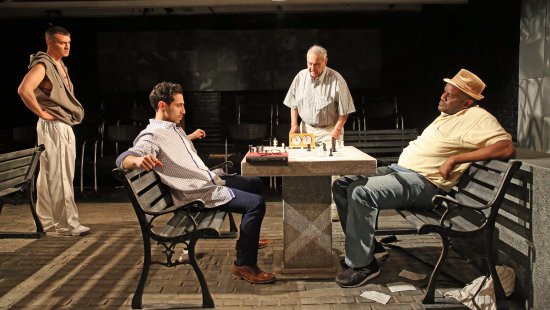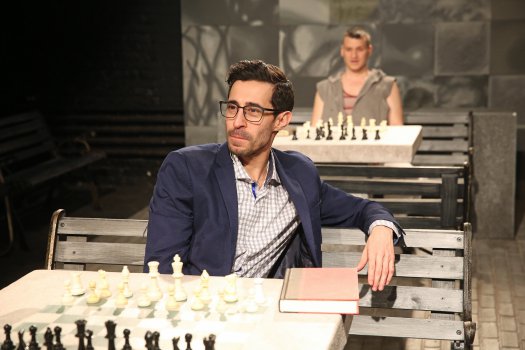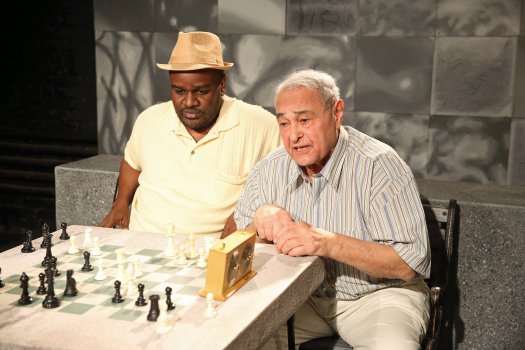Fish Men
Mamet-style con jobs among motley Washington Square Park chess players that’s very well acted and staged but is marred by drawn out and repetitious writing.

Gardiner Comfort, José Joaquín Pérez, Ed Setrakian and Shawn Randall in a scene from “Fish Men” (Photo credit: Carol Rosegg)
[avatar user=”Darryl Reilly” size=”96″ align=”left” ] Darryl Reilly, Critic[/avatar]This fitfully fascinating, but ultimately disappointing con job drama is set among a motley collection of Washington Square Park chess players. That it’s very well acted and staged compensates for its lack of tautness.
In Fish Men produced at the Goodman Theatre in 2012, playwright Cándido Tirado has crafted a David Mamet-style psychological exploration of chicanery with explosive dialogue. Unfortunately Mr. Tirado hasn’t emulated Mr. Mamet’s structural precision, and the play is marred by drawn out and repetitious writing.
What could have been an exhilarating conclusion is instead, a wearying one due to a length of two and hours and 20 minutes with an intermission. Still, Tirado has created five interesting and well-delineated characters and placed them in an intriguing setting.
In New York City’s in Washington Square Park, famous for its chess scene, we meet four players. The eloquent, African-American Cash, who dropped out of college just before obtaining a doctorate, and is in his late 30’s. Belorussian immigrant John is in his 30’s and is combative wheeler-dealer. They make a living as hustlers playing “fish,” eager but unskilled players who come into the park.
At a nearby table is Jerome. He is of Cherokee, American Indian extraction and is one of the last social chess players in the park. He does not play for money and often holds forth about the abuse of Native Americans at the hands of the European settlers in the United States.
He is visited by an elderly man, Adam, who is known as “92.” That is a chess reference and is also part of the tattoo on his arm. He is a retired barber and
Holocaust survivor. A former chess prodigy, he has long retired from the game and is haunted by the past.

José Joaquín Pérez and Gardiner Comfort in a scene from “Fish Men” (Photo credit: Carol Rosegg)
Mild-mannered Rey Reyes shows up, dressed in a suit, to pay off his uncle’s debt to Stuart, another player. The day before, his uncle heavily lost to Cash and John, and had to borrow money from Stuart to pay them. Rey is about 30 years old and is a computer programmer for a bank. He was born in Guatemala and fled his village with his uncle during a massacre that took the lives of their entire family. This has left him with emotional problems and ties him Adam, due to their similar traumas.
While Rey is waiting for Stuart, he plays chess with Cash and the dramatic confrontation of the play is begins.
Each character is conveniently a different, representative type of oppressed nationality. Though Tirado goes overboard in detailing these culturally diverse, downtrodden characters’ backstories with sociological overtones, and despite numerous tangents, there are very compelling portions, and the roles are rich opportunities for the talented cast.
As Cash, Shawn Randal delivers a powerhouse performance worthy of an August Wilson play. Funny, fierce, and philosophical, Mr. Randall is commanding.
In the complex part of Rey, José Joaquín Pérez winningly conveys the character’s volatility. The appealing Mr. Pérez undergoes several personality transformations. Pérez borders on being overwrought but manages to stay in the realm of reality with his strategically focused performance.
The gentle and forceful Ed Setrakian is a calm and welcome presence as Adam. With great dignity and wry humor, Mr. Setrakian looms over the action and also delivers a moving speech about a totemic, dried flower he keeps in his shirt pocket. That Setrakian is 88 years old makes his performance even more remarkable.

Shawn Randall and Ed Setrakian in a scene from “Fish Men” (Photo credit: Carol Rosegg)
Wiry, animated and employing a perfect accent, Gardiner Comfort is delightful as John. Like a hapless, second banana henchman in a gangster movie, Mr. Comfort’s appearance is a heady blend of comedy and pathos.
David Anzuelo is suitably low-key and brings a marvelous spiritual dimension to the part of Jerome. Mr. Anzuelo has an aura of serenity but is effectively active when it is called for.
Director Lou Moreno has a Herculean task in staging this verbose work that’s also filled with physical incidents. Mr. Moreno has aesthetically succeeded in infusing tension and visual variety into the presentation along with some riveting sequences and the excellent performances.
Raul Abrego’s inspired scenic design is a major asset of the production. The confined runway playing area is set with park benches, chess tables, and a water fountain. There are also park benches near the audience and at times actors sit in them adding dramatic qualities. The walls of the theater have tiles that are shades of gray. It’s all conveys the sense of actually being in Washington Square Park.
With brightness and occasionally concentrated red hues, Christopher J. Cancel-Pomales’ striking lighting design add considerable propulsion. Jesse Mandapat’s sound design is sparing and proficient. The characters are all realistically realized by Meghan E. Healey’s simple costume design that has individual sartorial flourishes.
If it were more refined, Fish Men could take its place among the classics of the grifter genre such as The Hustler, The Color of Money and Glengarry Glen Ross.
Fish Men (through March 18, 2017)
INTAR, 500 West 52nd Street, in Manhattan
For tickets, call 866-811-4111 or visit http://www.intartheatre.org
Running time: two hours and 20 minutes with one intermission






Leave a comment